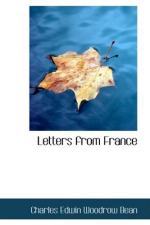It was by the sight of two or three English soldiers clambering up one of these jagged fragments and peering into whatever lay beyond it, that we knew, as we came in sight of Fricourt, that the village had already been taken. A string of men was winding past the end of the dust-heap into the dark wood behind it, where they became lost to view. Somewhere in the heart of the wood was the knock-knock of an occasional rifle. So the fight had gone on thither.
In front of us was a long gentle hill-slope, gridironed with trenches which broke out above the green grass like the wandering burrow of a mole. The last visible trench was in redder soil and ran along the crest of the hill. It passed through or near to several small woods and clumps of trees—the edges of them torn to shreds with shell-fire. They stood up against the skyline. In one of them, clearly visible, was a roadside crucifix.
Our men possessed the whole of that slope right into the trench at the top. We could see occasional figures strolling about the old German trenches—probably from posts established here or there behind the line of battle. All day long odd men wandered up or down some part of the hill-side—a guard with a German prisoner coming down, a messenger or stretcher-bearers going up. Now and then one could even see heads, with our flat steel helmets on them, showing out from the red trench against the skyline. So the fighting could not be severe at the moment on the crest of the hill.
Yet we were clearly not holding the whole of that skyline trench. On its southern or right-hand shoulder the hill ran into Fricourt Wood, which covered all that end of it. At the lower end of the wood, standing out against it, was the dusty yellow ruin which once was Fricourt. Behind that shoulder of the hill was a valley, of which we could see the gentle green slopes stretching away to Mametz and Montauban, both taken the day before, in the first half-day’s fighting. The green slopes must have been covered with the relics of that attack. But the kindly grass, the uncut growth of two years, hid them; and the valley, except for a few thin white trench lines, might have been any other smiling summer landscape.
When the wave of our attack swept through that country the Germans in Fricourt village and wood still held on. Another promontory was left jutting out into the wave of our attack in a similar village on our left—La Boiselle, where the main road for Bapaume runs straight out from our lines through the German front. We could see this heap of yellow-brown ruins sticking up beyond the left shoulder of the opposite hill much as Fricourt did on its right. There was a valley between, but it could only be guessed. Boiselle, too, had the remains of a small wood rising behind it. The bark hung from its ragged stumps as the rigging droops from the broken masts of a wreck.




